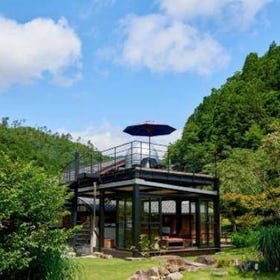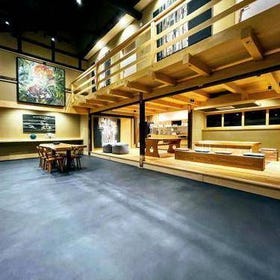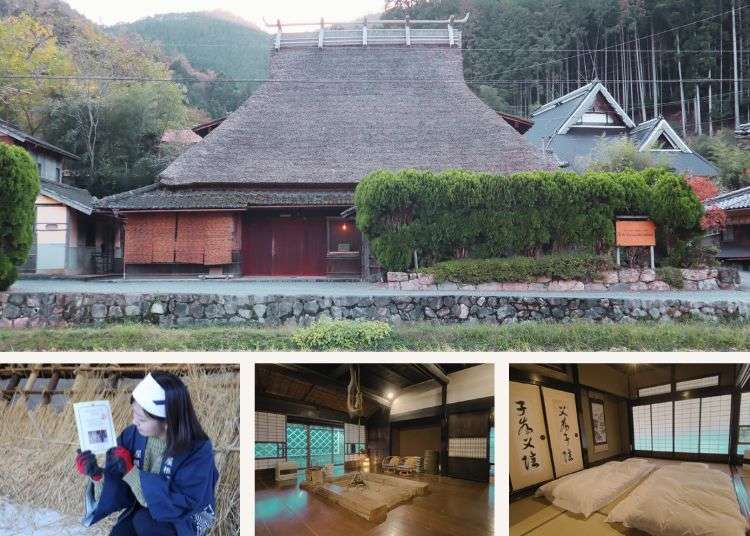
Miyama Futon & Breakfast: Stay at a 150-Year-Old Japanese Thatched Cottage in Kyoto
- Written by: Miyu Shimada
For a truly unique experience near Kyoto, Miyama Futon & Breakfast invites guests to stay in a kayabuki minka, a traditional thatched-roof home. This 150-year-old national cultural asset offers an intimate glimpse into Japan’s traditional lifestyle and sustainable living.
- Table of Contents
-
- What Are Kayabuki Houses?
- Miyama Futon & Breakfast: Where Guests Can Experience Kayabuki Home Life!
- Your Incredible Kayabuki Home Stay Starts at the Check-in Center!
- A Classic Japanese Hot Pot Party Around the Sunken Hearth
- A Morning Surrounded by Nature
- Our First Thatching Experience: A Technique Passed Down from Ancient Times
- Experience Recommendations and How to Spend Your Time
- Experience Traditional Japanese Culture at Miyama Futon & Breakfast
Part of the joy of traveling lies in experiencing things unique to the country or region you're exploring. Yet while seeing popular sights and staying at hotels is certainly fun, getting a glimpse into the lifestyle and wisdom of the locals adds a more personal touch to your trip.
Today, Miyu Shimada, a seasoned tour guide well-traveled both internationally and across Japan, introduces an inn where guests can stay in a kayabuki minka—a traditional Japanese thatched-roof home. Located a short distance from the tourist hotspot of Kyoto, this experience offers a glimpse into Japan's traditional and sustainable lifestyle.
What Are Kayabuki Houses?
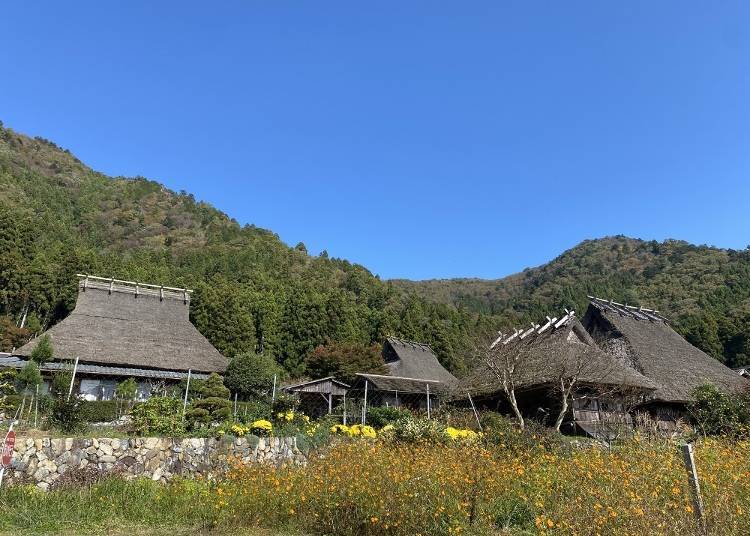
Thatched-roof kayabuki houses represent a truly Japanese landscape, a classic landscape often depicted in fairy tales, deeply ingrained in the childhood memories of many Japanese individuals. Even for modern-day folk who have never experienced living in one, these houses evoke a nostalgic charm, offering a glimpse into the good old days in Japan.

Roofs constructed using rice, straw, or other natural plant materials are known as “kayabuki” roofs, showcasing the ingenious craftsmanship and traditional expertise of the past. These roofs hold significant architectural value in modern Japan, partly because they cannot be newly constructed in urban areas due to their poor fire resistance and are so difficult to maintain and upkeep.
Miyama Futon & Breakfast: Where Guests Can Experience Kayabuki Home Life!
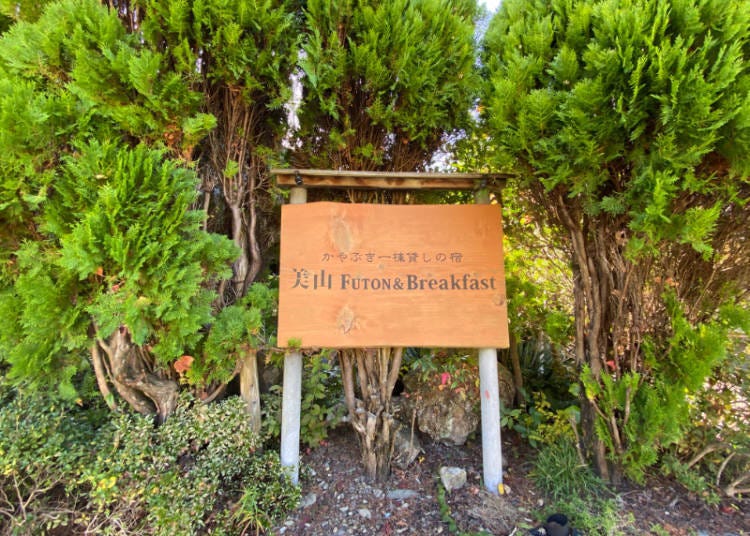
One inn that makes use of this very same thatch-roofed construction is Miyama Futon & Breakfast in Miyama-cho, Nantan City, a kayabuki home located in the middle of Kyoto Prefecture.

Built on the premise of “staying in Miyama as a resident,” the inn allows guests to immerse themselves in the unhurried lifestyle of ancient Japan, as if they were part of the local community itself.

There are a total of five accommodation buildings available, each tailored to various purposes and group sizes. Scattered throughout Miyama, these options include a traditional kayabuki house with a sunken hearth, and even a traditional residence with a dog run for those traveling with their canine companions.

Amongst these is Miyama Futon & Breakfast Honten, an establishment with over 150 years of history recognized as a National Tangible Cultural Property. It has also garnered international attention, with the BBC having recently visited to showcase the unique experience of staying at such a historic site.
Your Incredible Kayabuki Home Stay Starts at the Check-in Center!
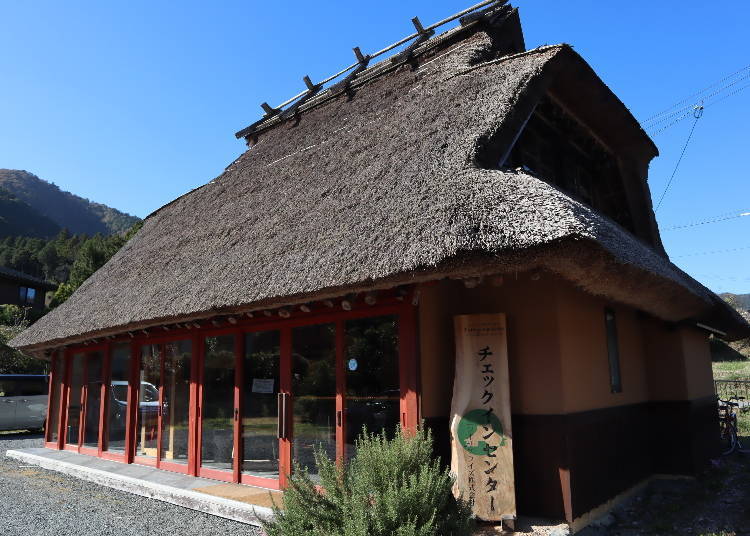
Each lodging is located in various points across the city, so you must first complete the check-in process at the check-in center.

Each building offers a luxurious single-unit rental experience, where meals, baths, and bedding are all self-service. It truly embodies a ’make yourself at home’ style of stay.

You’ll receive a quick room tour, covering how to use, what to expect, and how to check out.

Instructions are provided in English, traditional and simplified Chinese, and Japanese. In fact, there has been a recent surge in international visitors staying here lately!

We promptly make our way to our accommodation. The specific addresses of each building are not disclosed to the public, adding a sense of privacy and excitement. On this occasion, we stayed at Miyama Futon & Breakfast Honkan.

The exterior, the garden’s construction, and even the intricate details all exude a captivating ambiance, transporting visitors back in time.

Here is the main entrance.

Staff member Nishio kindly guided us through the check-in process and familiarized us with the inn's facilities. Interestingly, this old thatched-roof house just so happens to be the home of Nishio's parents, and where he was born and raised!

“When I was a child, I didn’t grasp the true value or beauty of this home; it was just an old house to me (laughs),” Nishio reminisces. “Now I deeply appreciate its worth, and I hope to preserve it for years to come, while sharing it with many people.”
His father, a skilled kayabuki craftsman, began operating this house as a lodging facility, and he himself gained several years of experience working at a hotel after high school graduation. They now work together as a family business.

The room features a traditional Japanese sunken hearth, perfect for cozy gatherings, dinner, and conversations by the fire.

Look at this wonderful tea room. Each room is spacious and offers the option to open the sliding doors for larger gatherings.

On the first floor alone are four Japanese-style rooms, a small alcove, a large living space with a sunken hearth, and a dining table on the earthen floor. Including an attic area, the house comfortably accommodates up to 10 people.
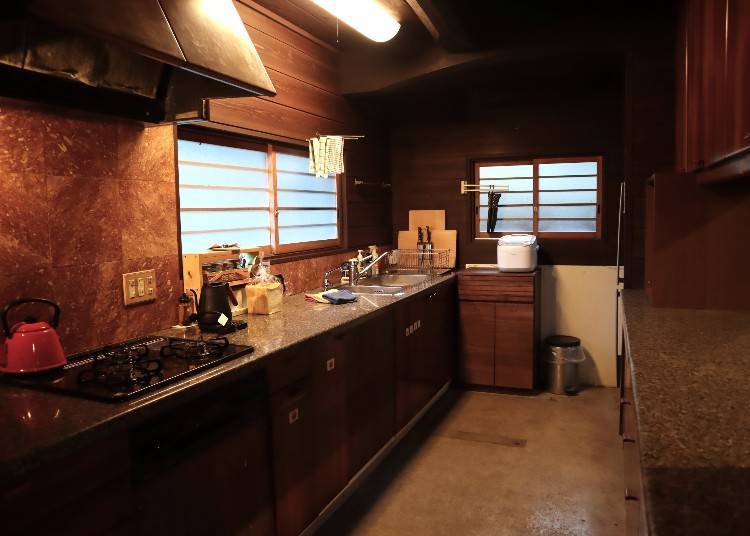
The kitchen boasts a spacious counter, and is equipped with basic cooking utensils like pots and pans, making it easy to prepare meals (or even BBQ!) for a large group. Just bring your favorite ingredients!

Free-to-use water servers are conveniently available.

The refrigerator is stocked with wine, bottled beer, and sake. Additionally, there’s a self-serve beer tap for your convenience (alcohol is charged separately).

Bath amenities like shampoo, body soap, toothbrushes, and towels are provided. However, there are no cosmetics or pajamas, so you’ll have to bring your own. At night, unwind in a relaxing herbal bath.

Sleeping on your own futon is another traditional Japanese way of life. Nowadays, most people sleep in beds, so a night on a futon once in a while is a delightful change of pace!

This is a traditional Japanese winter coat, known as a hanten. This warm, cozy garment is essential for a cold winter stay in a traditional Japanese house.

The attic space, once used for storing thatch and re-thatching supplies, is an intriguing space with its exposed thatched structure.

It also includes a loft which serves as a relaxation space with a table, sofa, books, and a mirror stand. You can even set up a futon for sleeping.

There’s also a magnificent warehouse located out back.

The inside of the warehouse is cool and quiet, ideal for conversations on a summer evening. In the center is a Japanese garden ornament known as suikinkutsu, which makes a lovely sound as water drops into it.

There’s also a chicken coop in the garden where you can watch the lively chickens running around.
A Classic Japanese Hot Pot Party Around the Sunken Hearth
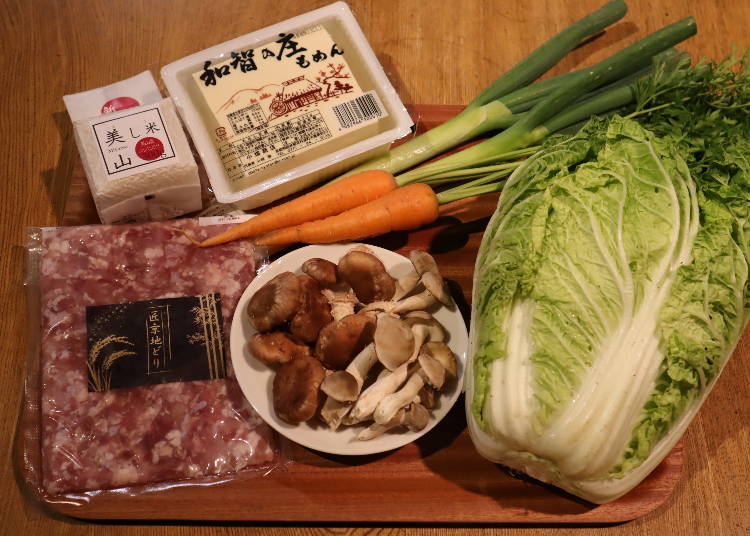
Having dinner over an open hearth using locally sourced Miyama ingredients is a highlight of a stay here. For our visit, we decided to make our own meals and bought the ingredients seen in the photo.
However, guests can also opt for the Irori Nabe Set, prepared by the inn. This allows you to enjoy a homemade Japanese hot pot, highly recommended for international guests seeking an authentic culinary experience!

Heat the charcoal with a burner to start the fire in the hearth.

The pot is filled with Miyama ingredients like chicken meatballs, mushrooms, tofu, leeks, and Chinese cabbage, all gently simmered over an open hearth fire.
We anticipate a delightful meal, feeling a sense of pride even before tasting it, as a dish cooked over the charcoal fire in an iron pot is bound to be delicious!

Using a wooden ladle further enhances the atmospheric charm.

The vegetables are bursting with freshness and flavor, while the jidori chicken makes for a good broth. Infused with the essence of these ingredients, it provides warmth for both body and soul.

Miyama Town, known for its pure water, is equally celebrated for its amazing rice. We had the pleasure of enjoying the new season's rice, freshly cooked and truly divine.

After dinner, unwinding in the attic space with its soft, indirect lighting is the perfect way to relax.

As night deepens and you step outside, you’ll be greeted by a magnificent starry sky. Upon advance request, the inn even offers a telescope, highly recommended for an exciting stargazing experience!
A Morning Surrounded by Nature
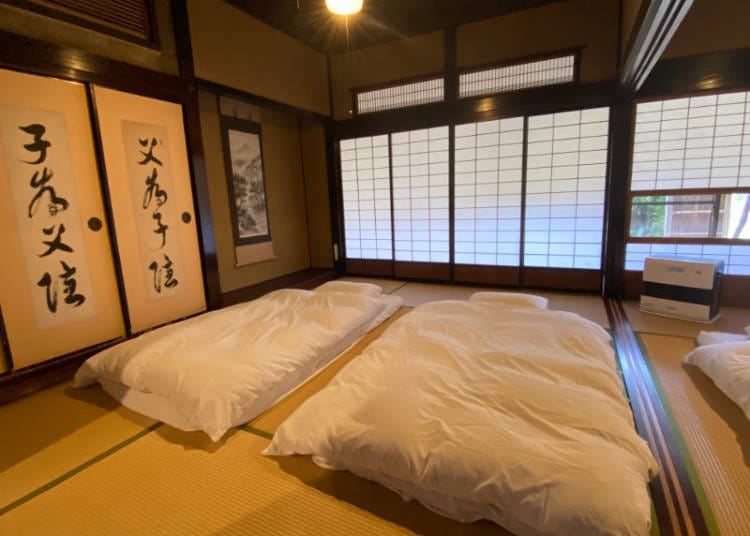
Rest peacefully on the soft futon and awaken to the gentle cooing of the chickens in the coop. It’s a delightful way to experience the richness of nature during your stay.

The breakfast includes Miyama milk, heirloom eggs, bread, blueberry jam, and an assortment of famous Miyama ingredients.

Our breakfast includes freshly brewed coffee and leftover gibier sausage and ham from the previous night’s meal. While we prepared it ourselves this time, if you stay at the main building under the basic plan, the staff will come prepare it for you.
Our First Thatching Experience: A Technique Passed Down from Ancient Times
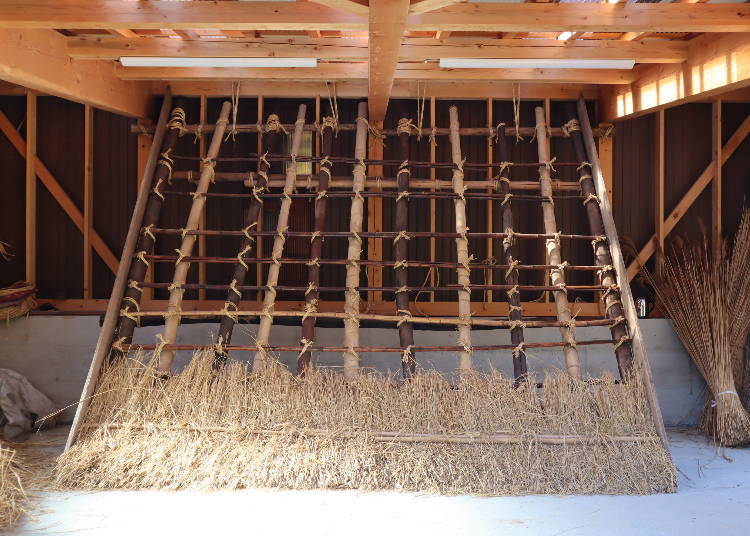
Miyama Futon & Breakfast presents numerous unique activities, including a rare thatching experience, allowing guests to try thatched roofing for themselves. This activity is also available as a day trip option, perfect for those not planning to stay overnight.

This was our first time trying this experience, made possible only at an inn with a thatched roof. Sporting our original happi jackets and craftsman’s-style tenugui hand towels, we eagerly begin our adventure.

It lasts about 2 hours and includes a classroom-style lecture and a demonstration. Nishio, whose father was a thatching craftsman and who himself experienced the field in the past, explains in detail.
We begin with the definition of kayabuki, or thatching. The “kaya” in kayabuki is a general term that refers to plants in the rice family, including awn and straw. The process of covering a roof using these materials is called ”kayabuki” in Japanese.

While symbolic of Japan’s original landscape, thatch-roof houses are not exclusive to Japan. In fact, they exist in numerous countries worldwide, often regarded as “the most prehistoric roofs.” Yet their designs and construction methods vary significantly, each with their own distinct characteristics, which has led to the development of a uniquely Japanese design.

"Thatched-roof houses were especially practical in humid Japan thanks to their great ventilation and ability to stay cool in the summer," explains Nishio.

After the lecture, the hands-on portion of class begins. For this experience, we use straw, considered to be the easiest of kaya materials to work with.

The process involves layering straw on top of poles made to resemble a roof, and securing it with rope.

It looks easy at first, but the task proved more challenging than expected! Most of all, when you consider that this work is typically performed on top of an actual roof, you really begin to gain a profound appreciation for the incredible skills and work of the craftsmen!

Throughout the experience, attentive hands-on guidance is provided. The lecture is also available in English, making it a great opportunity for international participants.

We prepare and finish the surface while crafting a gently sloping roof.

In the end, we take a commemorative photo, which is then printed on the spot.

The experience ends with a certificate featuring the photo.

You will also receive an original thatching experience guidebook that includes the basics of thatching, how to make thatch, the characteristics of thatching in Miyama, and much more. (English versions available).
Experience Recommendations and How to Spend Your Time

Staying in a thatched-roof house is a unique experience, even for Japanese visitors. We encourage you to plan an overnight stay to fully immerse yourself in this opportunity.
We recommend arriving at the inn by 3:00 p.m. for check-in, allowing time to unwind in the warehouse or the attic's loft space. Start dinner early, and enjoy a leisurely hot pot meal around the sunken hearth. As night falls, indulge in stargazing before relaxing comfortably on the futon. The next day, savor a delicious breakfast of Miyama ingredients before trying out the art of thatched roof craftsmanship for yourself. This itinerary promises lasting memories to remember!
For our visit, we cooked our own meals. However, there are a variety of other plans available, including an overnight stay with two meals and a BBQ lunch, so you can choose the option that best suits your preferences. They also offer a pick-up service from the nearest train station, and are available to provide guidance on local sightseeing activities, ensuring convenience for those using public transportation or who are simply unfamiliar with the area.

- The spacious ceilings and interior offers a cool atmosphere during summer, but can become chilly in winter. Heat is provided through stoves and warm coats, but bringing your own warm clothes are a must in cold weather.
- Unlike ordinary hotels and ryokan, the concept here emphasizes a “living at home” experience, so guests are responsible for their own meals and bed-making.
- Rules and guidelines for facility use are outlined in the inn's documents, so be sure to review them upon arrival.
- The only seasonings available are salt, sugar, pepper, and soy sauce, so we advise bringing any additional seasonings you may need.
- Given the rich natural surroundings, insects may be present, unlike in the city. However, they pose no harm, so please leave them alone as you enjoy the nature around you.
Experience Traditional Japanese Culture at Miyama Futon & Breakfast
Traditional homes possess a charm that modern architecture simply cannot replicate. And Miyama Futon & Breakfast especially exudes the emotions and warmth of its previous residents, and their preserved traditions and culture. A visit here promises a special experience, offering a glimpse into the Japanese lifestyle of the old days, their rich cultural heritage, and the surrounding natural beauty.
-

-
Address
52 Miyamacho Shima, Nantan-shi, Kyoto, 601-0751
View Map -
Nearest Station
Goma Station (JR San-in Line)
Vacancy search, reservation
-
from 55,000JPY 1room, 2adults
Check with our partner site as the latest rates, rate details, and guest room requirements may vary.
-
Address
52 Miyamacho Shima, Nantan-shi, Kyoto, 601-0751
Staying in Miyama? Check These Out!
Miyu is a travel writer and tour conductor with over a decade of experience in developing educational content for working individuals. She has a passion for exploring new cultures and has visited more than 150 cities in around 50 countries. Her goal is to sample great food, experience nature, enjoy historical sites, and bathe in hot springs around the world. Miyu left her corporate job to pursue her passion for travel and now spends over 100 days a year abroad while working as a writer. She promotes the joy of travel, the beauty of Japan, and the diverse cultures of the world by traveling to different parts of Japan and collaborating with inbound tour operators and fellow travel writers.
- Area
- Category
*Prices and options mentioned are subject to change.
*Unless stated otherwise, all prices include tax.
Popular Tours & Activitiess
Recommended places for you
-

Kanzenkoshitsuyakinikutabehodai Gyugyu Paradise Sannomiya
Yakiniku
Kobe, Sannomiya, Kitano
-
Goods

Yoshida Gennojo-Roho Kyoto Buddhist Altars
Gift Shops
Nijo Castle, Kyoto Imperial Palace
-

Jukuseiniku-to Namamottsuarera Nikubaru Italian Nikutaria Sannomiya
Izakaya
Kobe, Sannomiya, Kitano
-

Abeno Harukas
Landmarks
Shinsekai, Tennouji, Tsuruhashi
-

ISHIDAYA Hanare
Yakiniku
Kobe, Sannomiya, Kitano
-

Kambei Sannomiyahonten
Yakiniku
Kobe, Sannomiya, Kitano
-

Everything You Need to Know About teamLab Biovortex Kyoto (2025 Insider Guide)
by: Wemmy Chau
-
Ad

Discover Timeless Beauty: Kimono-en, a Web Magazine Exploring the Spirit of Kimono
-

Celebrate a Dreamy Barbapapa Christmas at JR Osaka Station's Twilight
by: Guest Contributor
-

November Events in Kansai: Fun Festivals, Food, and Things to Do in Kyoto & Osaka
-
Ad

Experiencing Manga as Culture, Not Just Reading It: Expo 2025 with Rumiko Takahashi
-
Ad

Recharge and Relax with a Healing Getaway at Kamenoi Hotel Toba
Inspiration for Accommodations
-

Spacious Family Hotel in Namba: 20 Comfortable Stays for Family Fun
-

Charming Hotels to Enjoy the Spectacular Views of Arashiyama's Autumn Leaves from Your Room
-

Experience Stunning Views of Osaka Castle from Private Spaces: Top Hotels Near Osaka Castle
-

Recommended by Visitors! Arashiyama's Best-Rated Hotels
-

Family-Friendly Universal Studios Japan Hotel with Excellent Access
-

Enjoy a Comfortable Stay in Osaka! 10 Hotels with Convenient Airport Shuttle Services
-

Top 10 Recommended Hotels Near Namba Station with Great Access
-

Enjoy Night Views from Your Room! Recommended Hotels in Namba Area
-

5 Popular Shops and Gift Ideas Along Arashiyama Shopping Street
-

Kiyomizu-dera Temple: Guide to Visiting Kyoto's Most Famous Sightseeing Spot
-

THE LIVELY Osaka Honmachi: This Cutting-Edge Dream Hotel Awaits You!
by: WESTPLAN
-

Ippudo Osaka and More: These 5 Ramen Restaurants in Osaka Are Going Viral
by: WESTPLAN
-

5 Kyoto Shukubo: Opt for a Temple Stay in Kyoto and Immerse Yourself in Tranquility
by: Chehui Peh
-

(Video) Walking Tour along Narita Omotesando - Quaint Historical Village near Narita Airport!
by: Victor Gonzalez
- #best gourmet Osaka
- #things to do Osaka
- #what to do in kyoto
- #what to bring to japan
- #best gourmet Kyoto
- #new years in Osaka
- #what to buy in nanba
- #Visiting Osaka
- #onsen tattoo friendly arima
- #daiso
- #Visiting Kyoto
- #best japanese soft drinks
- #japanese fashion culture
- #japanese convenience store snacks
- #japanese nail trends













